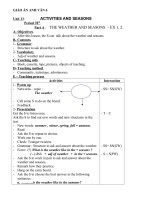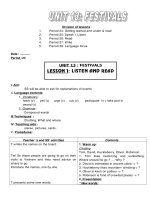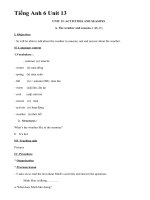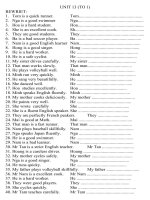Unit 13 - Anh K10-Gia Hoang
Bạn đang xem bản rút gọn của tài liệu. Xem và tải ngay bản đầy đủ của tài liệu tại đây (226.82 KB, 16 trang )
Tu Ky High School – Lesson Plan – Grade 10
TiÕt thø: 78
Ngµy so¹n: 02/03/2008
Unit 13 films and cinema
A. Reading
I. Objectives
By the end of the lesson students will be able to:
- Develop such reading micro-skills as skimming for main ideas, summarizing main ideas,
scanning for specific ideas, and guessing meaning in context.
- Use the grammatical structure "It was not until ... that... " and cinema vocabulary such as silent
films, screen, character and so on in order to read and talk about the topic.
II. Materials
Textbook, handouts.
III. Anticipated problems
Students may not have sufficient vocabulary to talk about the topic. They may also find the
structure "It was not until ... that..." difficult to understand and use.
IV: procedure
Steps
Work
arrangement
Time
WARM UP
Cinema Crossword Puzzle
- T divides the class into small groups of 3-4 students. Then T distributes
the following crossword puzzle handouts for Ss to do in their own groups.
Which group finishes first and has all the correct answers will be the
winner.
- T introduces the topic "'Films and cinema".
Across:
2. A film that makes you laugh is a _____.
5. The person who makes a film.
7. All the people who act in a film.
8. The story of a film.
Down:
1. The music of a film.
3. The word of a film.
4. A film that frightens you is a _____ film.
6. The most important actor in a film.
1
2
3 4
5
6
7 8
Answer:
S
Group work 5'
NguyÔn Thanh TuÊn
Trang 188
Tu Ky High School – Lesson Plan – Grade 10
C O M E D Y
U
N S H
D I R E C T O R
T R R
R S I R
C A S T P L O T
C A T R
K R
BEFORE YOU READ
- T draws this network on the board and elicits class cinema vocabulary
from Ss, for example:
- T makes sure Ss understand the meaning of these words and teaches
their pronunciation, if necessary.
- T then guides Ss to discuss the following questions in pairs:
1. Do you want to see a film at the cinema or on TV? Why?
2. Can you name some of the films you have seen.
3. What kind of films do you like to see? Why?
- T goes around to offer help
Pre-teach vocabulary:
Note: T should not teach those words that will appear in Task 1.
• Motion (n): the act of moving, or changing place or position
(chuyển động)
• Set st in motion: Move st
• Still (a): silent
• Audience (n): Viewers
• Spread (v): to extend over a place
• Replace (v): thay thế
Pre-teach new structure:
+ Form: It was not until TIME that CLAUSE
+ Meaning: This structure means the same as not ... before. It refers to the
commencement point of an action or event in the past.
E.g.: It was not until last year that we began this program = We did not
begin this program before last year = We began this program last year.
+ Use: This structure is used to emphasize the commencement point of an
action or event.
- T should get Ss to make sentences with this new structure and makes
sure they understand and can use it correctly.
Pair work &
Whole class
7'
WHILE YOU READ
Set the scene: You are going to read about the work and history of
cinema
NguyÔn Thanh TuÊn
Cinema
Romantic film
Science fiction film
Horror film
Comedy
Cartoon
Thriller
Detective film
Action film
Drama
Trang 189
Tu Ky High School – Lesson Plan – Grade 10
Task 1:
Instruction: You are going to read the passage silently and then do Task
1.
- T gets Ss to read the passage individually.
- After checking that Ss have finished reading the passage, T instructs Ss
to use some strategies to do task 1:
+ First, Ss should read through the definitions provided in the task to
identify the part of speech of the word to match each definition. For
example, in sentences 1, 2, 3 and 4 the word to fill in should be a noun,
and in sentence 5 it should be an adverb.
+ Then, Ss should go back to the passage and find the suitable words to
fill the table.
- T goes around helping Ss when necessary.
- Then T asks Ss to check their answers in pairs.
- T calls Ss to present and explain their answers.
- Finally, T provides the correct answers.
Answer:
1. Cinema 2. Sequence 3. Decade
4. Rapidly 5. Scene 6. Character
Task 2:
Instruction: You are to read the 'passage again and answer the questions
in the book.
- T instructs Ss to use some strategies to do the task:
+ First, ask Ss to read through the six questions to understand them and to
underline the key words.
For instance, in question 1 Ss can underline history of cinema and begin,
in question 2 they can underline discover...
+ Then Ss should locate the information for each question by finding the
key words in the passage and mark the place.
- T asks Ss to work individually to answer the questions.
- Then T asks Ss to discuss their answers with their peers.
- T calls on some Ss to present and explain their answers.
- Finally, T feedbacks and gives the correct answers:
1. In the early 19th century (line 1)
2. At that time the scientists discovered that when a sequence of still
pictures was set in motion, they could give the feeling of movement.
(lines 2-3)
3. No they didn't (line 5, lines 13-15: the early films were no more than
moving photographs and it was not until the end of 1920 that sound
was introduced)
4. In the early 1910s (line 9)
5. At the end of the 1920s (line 14)
6. The musical cinema (line 17)
Task 3:
Instruction: Read the passage one more time and find the most suitable
title for it.
- T instructs Ss to use some strategies for this kind of task:
+ First, Ss read the options A, B, and C and find out the differences
Individual
work, Pair
work &
Whole class
7'
7'
5'
NguyÔn Thanh TuÊn
Trang 190
Tu Ky High School – Lesson Plan – Grade 10
between them. For example, option A suggests that the passage is about a
film maker, option B suggests that the passage is about the brief history of
cinema.
+ Then, they go back to the passage, and read the first and the last
sentence to decide the main idea
- T gives Ss some minutes to do the task and checks with the whole class.
Answer: B (the passage briefly presents the development of the cinema
from the old silent films to musicals)
AFTER YOU READ
Instruction: You are going to work in groups and talk about the history
of cinema, using these dates: 19th century, 1905, 1910s, 1915, 1920s
- T gets Ss to work in groups of 3 or 4 and take notes of the' main events
described in the passage, based on the cues given in the textbook. For
example:
19th century History of cinema began
1905
Films were about 5-10 minutes long
(longer than early films which lasted
only one minute)
1910s The first long films were made
1915
Films became even longer and better.
Cinemas were first built
1920s
Sound was introduced and old silent
films were replaced by the spoken ones
- Then, Ss take turn to talk about the history of cinema based on their
notes.
- T goes around offering help.
- Finally, T calls on some Ss to speak and gives them feedback.
Group work 10'
WRAPPING
- T summarizes the main points.
- For homework, T asks Ss to write a summary of the passage using their
notes taken for the After
You read task.
Whole class 3'
Rót kinh nghiÖm giê d¹y:
...........................................................................................................................................................................
...........................................................................................................................................................................
Extra activity
Match the titles of these films with their Vietnamese translations:
1. Gone with the wind A. Hồn ma
2. The thorn birds B. Nhật ký tiểu thư Jones
3. Love Actually C. Xác ướp trở lại
4. Lion King D. Cuốn theo chiều gió
5. Hero E. Tiếng chim hót trong bụi mận gai
6. Bridget Jones' Diary F. Yêu thật sự
7. Mummy returns G. Anh hùng
8. Ghost H. Vua Sư tử
NguyÔn Thanh TuÊn
Trang 191
Tu Ky High School – Lesson Plan – Grade 10
9. Pearl Habour I. Vẻ đẹp Mỹ
10. American beauty J. Trân châu cảng
Answer:
1. D 2. E 3.F 4.H 5. G 6. B 7.C 8. A 9. J 10.I
TiÕt thø: 79
Ngµy so¹n: 04/03/2008
Unit 13 films and cinema
B. Speaking
I. Objectives
By the end of the lesson students will be able to:
- Ask and answer questions about the plot of a film based on prompts
- Tell what kinds of film they like and dislike
- Express their opinions about a film, using attitudinal adjectives
II. Materials
Textbook, handouts, some film posters
III. Anticipated problems
Students might not have sufficient vocabulary to talk about the topic. They might also have
difficulty with the structure Sb find st/sb + Adj and confuse between adjectives ending in -ing
and -ed.
IV: procedure
Steps
Work
arrangement
Time
Task 1:
- T asks Ss to study the table on p.134 and tick the boxes that suit their
preferences for a particular type of films.
- Then T asks Ss to move around the classroom and find as many friends
that have the same preferences as them as possible. (If the class is
large, T may want to ask Ss to interview those friends sitting behind and
in front of them only). Ss have to take notes of who and how many friends
like or dislike the same types of films as them.
- T then calls on some Ss to report their likes and dislikes and the number
of friends who have the same tastes as them.
Task 2:
Pre-teach vocabulary -and grammar:
- T gets Ss to brainstorm all the adjectives that can be used to describe
films, e.g. interesting, exciting, fascinating, amusing, boring, horrifying...
Note: Ss may confuse these adjectives with their "ed" counterparts, so T
should be ready to explain the differences (e.g. I'm interested in action
films vs. Action films are interesting).
- Then T asks Ss to look at the adjectives in the right hand column to see
if they do not know any of the words. T explains the meaning of new
words if any.
- T introduces the structure Sb find st/ sb + adj, which can be used to
express one's opinion about something or someone. E.g.: I find horror
films fascinating. Then T gets Ss to make sentences with the structure. T
needs to make sure that Ss get it right.
Individual
work and
mingling
activity
Whole class
& Group
work
7'
NguyÔn Thanh TuÊn
Trang 192
Tu Ky High School – Lesson Plan – Grade 10
- T elicits the expressions of agreement and disagreement:
Agreement Disagreement
I agree
Yes, exactly
Right!
Sure!
I don't think so
Yes but ...
Do you think so?
You can't be serious!
You must be kidding!
Note: T may want to get across to Ss that direct expressions like "I don't
agree" or "I disagree" are unacceptable in English because they're too
assertive.
- T calls on three Ss to read the model conversation in the textbook. T
corrects Ss' intonation and pronunciation if necessary.
- Then T divides the class into small groups of 3 and instructs Ss to find
out what the other members of their group feel about the given types of
films. Ss should base themselves on the model conversation.
- T goes around offering help.
- Finally, T calls on some Ss to report their findings.
While they speak, T takes note of their errors if any and corrects them
after that.
Task 3:
Pre-teach grammar:
- T introduces the structure "Prefer st to st ", which can be used to talk
about one's preferences. E.g.: I prefer romantic films to action films.
Then T gets Ss to make sentences with the structure. T needs to check that
Ss can use the structure correctly.
- T calls on two Ss to read the model conversation in the textbook. T
corrects - Ss' intonation and pronunciation if necessary.
- Then T instructs Ss to work in pairs and find out about their partner's
preference for a particular type of films, basing them on the model
conversation.
- T goes around offering help.
-Finally, T calls on some Ss to report their findings. While they speak, T
takes note of their errors if any and corrects them after that.
Task 4:
- T instructs Ss to work in pairs and ask and answer questions about a film
that they have seen, using the suggestions given in the textbook. T asks Ss
to take notes of their friend's story.
- T goes around offering help.
- Finally, T calls on some Ss to report their friend's story. While Ss speak,
T takes note of their errors if any and corrects them after that.
Pair work
Pair work
8'
10'
WRAPPING UP
- T summarises the main points of the lesson.
- T asks Ss to make sentences with the new words and structures at home.
Whole class 3'
Rót kinh nghiÖm giê d¹y:
...........................................................................................................................................................................
NguyÔn Thanh TuÊn
Trang 193









